Selecting the perfect whitewater kayaking paddle is probably the most important decision you will make as a boater. That’s because the paddle is your tool to transfer energy to the water. Choosing the proper blade shape will allow you to perform at the highest level for your style of boating, and understanding how to get the perfect fit will allow you to be more comfortable, use less energy and spend more time on the water.
The paddle becomes an extension of your upper body, so the most logical choice is to use one that feels good to you. Designs vary slightly, but the general anatomy of whitewater paddles is the same. The two blades are attached to a shaft that can be straight or bent in various ways. The blades may be symmetrical or asymmetrical in shape, but all have a slightly concave power (front) face and a non-power (back) face.
Your considerations are going to be a bit different than they would be if you were choosing a flat water paddle. A whitewater paddle needs to be strong, durable and performance oriented. Although it’s an important decision, it doesn’t have to be hard. Here are some general considerations to keep in mind as you make your selection:
- Your size and experience
- Blade size and shape
- Paddle length
- Shaft options
- Paddle material
Your size and paddling experience
Paddler height
The most influential factor in choosing a paddle is your size and overall experience. Other factors like length of the paddle, the width of the shaft, or the size and shape of the blades will be secondary, though still important.
Smaller paddlers should look for a paddle with slightly smaller blades and with a narrower shaft that makes it easier to grip. The stronger you are, the larger the paddle blades you will be able to control. Using a paddle that is too long or too large will cost you some control and could put an undue amount of stress on your body. For example:
- Paddlers 5'3" to 5'8" would likely prefer a paddle between 190-196 cm
- Paddlers 5'9" to 6'1" would prefer a paddle between 196-200 cm
- Paddlers taller than 6'1" would prefer a paddle over 200 cm.
The industry is starting to "size up" on lengths, but these are general guidelines to adhere to.
River running size chart
| Paddler Height | Paddle Length |
|---|---|
| 4'8" - 5'2" (142 - 157cm) |
191cm |
| 5'2" - 5'8" (157 - 173cm) |
194cm |
| 5'8" - 6' (173 - 183cm) |
197cm |
| 6' - 6'3" (183 - 191cm) |
200cm |
|
6'3" and Taller |
203cm |
Play boating size chart
| Paddler Height | Paddle Length |
|---|---|
| 4'8" - 5'2" (142 - 157cm) |
188cm |
| 5'2" - 5'8" (157 - 173cm) |
191cm |
| 5'8" - 6' (173 - 183cm) |
194cm |
| 6' - 6'3" (183 - 191cm) |
197cm |
|
6'3" and Taller |
200cm |
Charts provided by Werner Paddles
Paddler experience
Paddlers looking for more power and stability in their strokes may consider a larger blade size. On the other hand, you’ll generally get more efficiency in your paddle strokes with a mid-size blade. Shorter paddle lengths tend to be great for those who are looking for a more aggressive paddle stroke, which can be beneficial when performing play boat maneuvers.
Understanding your own experience and style can help you choose the right paddle blade, as well as the right length, blade size and desired offset. If you have any questions about your paddling style and the best paddle for you, we’re always happy to help and offer suggestions!
Blade size and shape
Shape
Whitewater paddles come in two basic shapes, River runners and play paddles.
River Runners
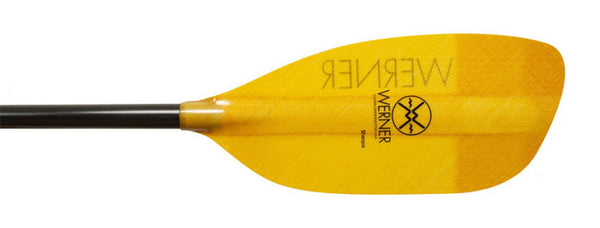
With a more pronounced tip and more surface area above the center of the blade, this design is optimized for a better forward stroke. These blades are the best choice for the core elements of river running; pulling yourself through or over holes and drops, breaking in and out of features and ferrying across current. The best whitewater boaters in the world have believed in, trusted and tried our designs for decades. Our white water designs have a slight dihedral for smooth vertical maneuvering strokes. Note we also flatten the back face spine to aid in these strokes.
Play Boating
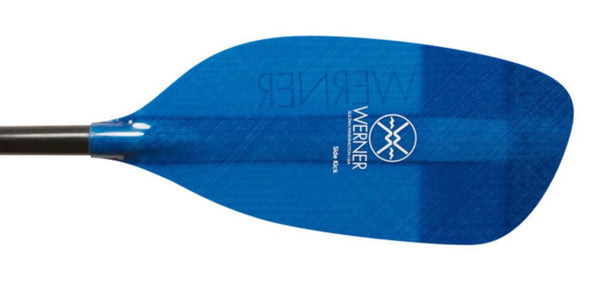
The second blade shape is commonly referred to as a play blade. These blades have a larger portion of the surface area below the center giving the blade its down turned shape. This shape allows for enhanced maneuverability when linking strokes. This blade shape excels to help boat control, surf waves or to set up for today's most advanced moves. These blades are also a favorite of ocean surfers, in white water boats, wave skis, or surf boats. Our white water designs have a slight dihedral for smooth vertical maneuvering strokes.
Size
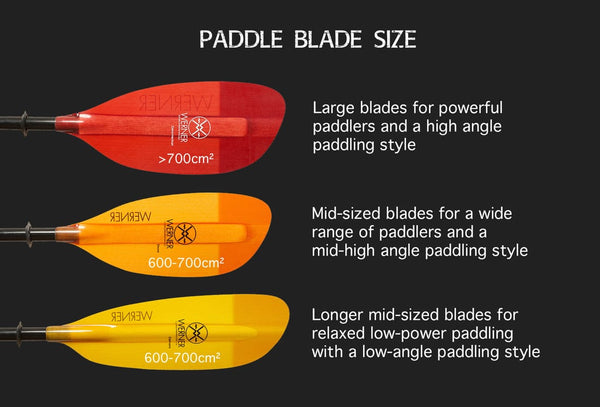
The blade size that works best for you will depend on your body type and fitness level. While a blade with more surface area will push more water, a bigger blade does not make every paddler more powerful. Smaller and less advanced paddlers may find that a blade with a small or medium surface area puts less stress and strain on the body while allowing more efficient strokes.
Paddle length
Now that you have the proper blade shape for your paddling style, let’s be sure you have the perfect fit. The perfect fitting paddle will assure comfort and paddling efficiency.
River running paddles
River running paddles will always be longer, again due to the importance of the “catch”. The catch is where the blade first enters the water, where you have the most energy in your stroke. So if your paddle has some extra length you will have more “catch length” and take fewer, more powerful strokes. Generally speaking, 194 cm fits shorter people, 197 cm fits those of average height, 200 cm works well for taller paddlers. For a more in-depth look, especially for uniquely sized paddlers, check out the Werner Paddle Fit Guide.
Play boating paddles
Play boating paddles tend to be shorter, as you will need to perform more dynamic paddle strokes when performing play boat maneuvers. You will also need to take much faster, higher cadence strokes as you attain upstream to catch waves or drop into holes. As a general rule of thumb, short people should look at a 191 cm, paddlers of average height to 194 cm, and those long folks to 197 cm. For a more in depth look, especially for uniquely sized paddlers, check out the Werner Paddle Fit Guide.
Shaft Options
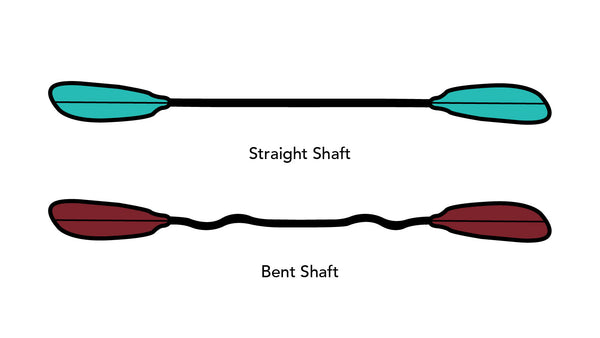
Straight shaft
Straight shaft paddles have a familiar feel and many paddlers are used to them. They are also a lighter and a less expensive option. Using good technique—lightly gripping the shaft, with your hands forming the “okay” symbol—you can enjoy all-day, pain-free paddling.
Bent shaft
Bent shaft paddles are a great choice for those who have developed some aches and pains in their hands and wrists. Paddlers who hold on too tightly to their paddle (and let’s face it, we all do when we get nervous) will also benefit. By always keeping the wrists in an ergonomically correct straight alignment, less pressure is put on the small tendons and ligaments of the wrist, reducing pain. Bent-shaft paddles are more expensive, but the expense is justified if it helps you paddle pain free.
Shaft Diameter
Paddle manufacturers like Werner Paddles offers two shaft diameters to comfortably accommodate different sizes of hands. Proper shaft diameter allows paddlers to use a more relaxed, low-stress grip. If your hand is larger than 7 inches from the base of your palm to your fingertip, you will want the standard-diameter shaft. If the length is less than 6.5 inches, choose the small diameter shaft. In between, you can go either way.
Paddle Material
Whitewater paddles are broken into a couple of different parts, the blade and the paddle shaft being the most prominent. As we discussed earlier a whitewater paddle needs to be strong, durable and efficient. The materials that make up your blades and shaft will have a direct effect on all of the above. When looking at the best paddles for whitewater kayaking, there are several different materials to choose from, each has its benefits.
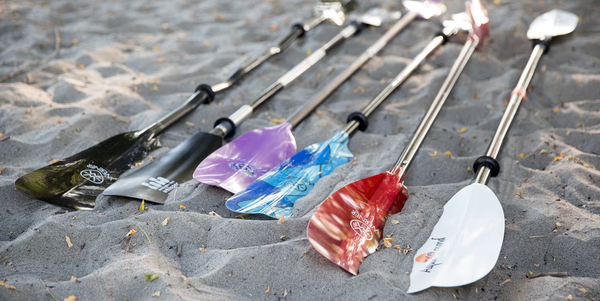
When browsing selections of high-quality whitewater kayak paddles, you’ll find yourself comparing carbon paddles and fiberglass paddles. Choosing the right material for you is going to help you get the best out of your gear and boating experience. Following are pros and cons of each material type and how they're used in the paddle.
Aluminum shaft
Aluminum shaft whitewater paddles are a great choice for those who are looking for the most affordable option. This is regularly a preferred material choice for recreational kayakers, and those who don’t have a lot of experience under their belt.
Pro: This affordable material is durable and flexible.
Con: Flexibility can come at the cost of efficiency.
Fiberglass shaft
Fiberglass whitewater kayak paddles hold a lot of benefits. Paddlers will quickly find that a fiberglass kayak paddle is strong, yet lightweight. It’s a little more flexible than other options like carbon, which is good for those with weaker or sensitive wrists.
Pro: Strong, yet lightweight and more flexible
Con: Fiberglass paddles tend to offer a little less power per stroke.
For reference check out the Werner Powerhouse Straight Shaft Kayak Paddle!
Carbon shaft
Carbon kayak paddles are a fantastic option if you’re looking for the most lightweight choice. They are also the most powerful of the material options, making them great for many whitewater kayaking adventures.
The benefits a carbon paddle offers are great, however, you’re going to be paying more for your paddle. Carbon is one of the most expensive kayak paddle options. In addition, while carbon paddles take a lot to wear down, they offer very little flexibility. Ultimately, they do not bend, and if they reach a certain pressure threshold, they will break.
Pro: Most powerful and lightweight choice. Great for whitewater kayaking.
Con: Most expensive option and less flexibility
For reference, check out the Accent Rogue Advantage Whitewater Kayak Paddle.
Conclusion
At the end of the day, there is never a black and white, right or wrong configuration when selecting a paddle. The important thing to remember is that a lot of these topics are “feel” based, therefore completely subjective and subject to change from person to person, so get out there and experiment! Try longer paddles and try shorter paddles with varying cadences. Try bent shafts or straight shafts. Try different paddle materials. Find out what feels best and works best for you.
Please feel free to contact Festive Water with any questions regarding paddle selection at 404-422-9569.
--
Article References:
- https://www.nrs.com/learn/choose-a-whitewater-paddle
- https://coloradokayak.com/blogs/cks-blog/whitewater-kayak-paddle-buying-guide
- https://www.olympicoutdoorcenter.com/pages/choosing-a-whitewater-kayak-paddle
- https://wernerpaddles.com/pages/whitewater-design-fit












